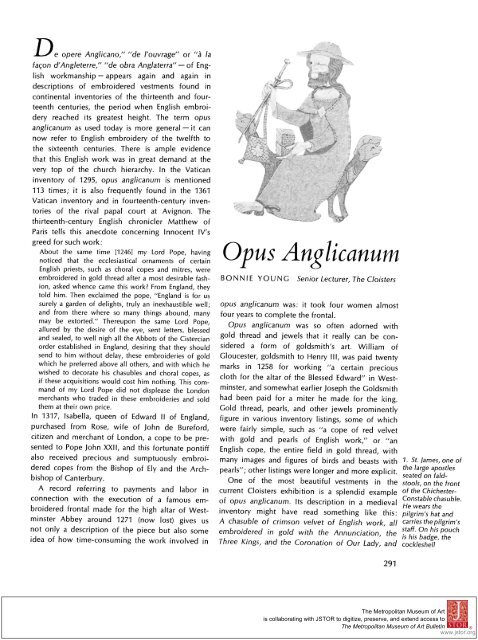The Metropolitan Museum of Art Bulletin, v. 29, no. 7 (March, 1971)
The Metropolitan Museum of Art Bulletin, v. 29, no. 7 (March, 1971)
The Metropolitan Museum of Art Bulletin, v. 29, no. 7 (March, 1971)
Create successful ePaper yourself
Turn your PDF publications into a flip-book with our unique Google optimized e-Paper software.
D e opere Anglica<strong>no</strong>," "de I'ouvrage" or "a la<br />
facon d'Angleterre," "de obra Anglaterra"- <strong>of</strong> English<br />
workmanship- appears again and again in<br />
descriptions <strong>of</strong> embroidered vestments found in<br />
continental inventories <strong>of</strong> the thirteenth and fourteenth<br />
centuries, the period when English embroidery<br />
reached its greatest height. <strong>The</strong> term opus<br />
anglicanum as used today is more general - it can<br />
<strong>no</strong>w refer to English embroidery <strong>of</strong> the twelfth to<br />
the sixteenth centuries. <strong>The</strong>re is ample evidence<br />
that this English work was in great demand at the<br />
very top <strong>of</strong> the church hierarchy. In the Vatican<br />
inventory <strong>of</strong> 1<strong>29</strong>5, opus anglicanum is mentioned<br />
113 times; it is also frequently found in the 1361<br />
Vatican inventory and in fourteenth-century inventories<br />
<strong>of</strong> the rival papal court at Avig<strong>no</strong>n. <strong>The</strong><br />
thirteenth-century English chronicler Matthew <strong>of</strong><br />
Paris tells this anecdote concerning In<strong>no</strong>cent IV's<br />
greed for such work:<br />
About the same time [1246] my Lord Pope, having<br />
<strong>no</strong>ticed that the ecclesiastical ornaments <strong>of</strong> certain<br />
English priests, such as choral copes and mitres, were<br />
embroidered in gold thread after a most desirable fashion,<br />
asked whence came this work From England, they<br />
told him. <strong>The</strong>n exclaimed the pope, "England is for us<br />
surely a garden <strong>of</strong> delights, truly an inexhaustible well;<br />
and from there where so many things abound, many<br />
may be extorted." <strong>The</strong>reupon the same Lord Pope,<br />
allured by the desire <strong>of</strong> the eye, sent letters, blessed<br />
and sealed, to well nigh all the Abbots <strong>of</strong> the Cistercian<br />
order established in England, desiring that they should<br />
send to him without delay, these embroideries <strong>of</strong> gold<br />
which he preferred above all others, and with which he<br />
wished to decorate his chasubles and choral copes, as<br />
if these acquisitions would cost him <strong>no</strong>thing. This command<br />
<strong>of</strong> my Lord Pope did <strong>no</strong>t displease the London<br />
merchants who traded in these embroideries and sold<br />
them at their own price.<br />
In 1317, Isabella, queen <strong>of</strong> Edward II <strong>of</strong> England,<br />
purchased from Rose, wife <strong>of</strong> John de Bureford,<br />
citizen and merchant <strong>of</strong> London, a cope to be presented<br />
to Pope John XXII, and this fortunate pontiff<br />
also received precious and sumptuously embroidered<br />
copes from the Bishop <strong>of</strong> Ely and the Archbishop<br />
<strong>of</strong> Canterbury.<br />
A record referring to payments and labor in<br />
connection with the execution <strong>of</strong> a famous embroidered<br />
frontal made for the high altar <strong>of</strong> Westminster<br />
Abbey around 1271 (<strong>no</strong>w lost) gives us<br />
<strong>no</strong>t only a description <strong>of</strong> the piece but also some<br />
idea <strong>of</strong> how time-consuming the work involved in<br />
Opus<br />
BONNIE YOUNG<br />
Anglicanum<br />
Senior Lecturer, <strong>The</strong> Cloisters<br />
opus anglicanum was: it took four women almost<br />
four years to complete the frontal.<br />
Opus anglicanum was so <strong>of</strong>ten adorned with<br />
gold thread and jewels that it really can be considered<br />
a form <strong>of</strong> goldsmith's art. William <strong>of</strong><br />
Gloucester, goldsmith to Henry III, was paid twenty<br />
marks in 1258 for working "a certain precious<br />
cloth for the altar <strong>of</strong> the Blessed Edward" in Westminster,<br />
and somewhat earlier Joseph the Goldsmith<br />
had been paid for a miter he made for the king.<br />
Gold thread, pearls, and other jewels prominently<br />
figure in various inventory listings, some <strong>of</strong> which<br />
were fairly simple, such as "a cope <strong>of</strong> red velvet<br />
with gold and pearls <strong>of</strong> English work," or "an<br />
English cope, the entire field in gold thread, with<br />
many images and figures <strong>of</strong> birds and beasts with<br />
pearls"; other listings were longer and more explicit.<br />
One <strong>of</strong> the most beautiful vestments in the<br />
current Cloisters exhibition is a splendid example<br />
<strong>of</strong> opus anglicanum. Its description in a medieval<br />
inventory might have read something like this:<br />
A chasuble <strong>of</strong> crimson velvet <strong>of</strong> English work, all<br />
embroidered in gold with the Annunciation, the<br />
Three Kings, and the Coronation <strong>of</strong> Our Lady, and<br />
<strong>29</strong>1<br />
1. St. James, one <strong>of</strong><br />
the large apostles<br />
seated on faldstools,<br />
on the front<br />
<strong>of</strong> the Chichester-<br />
Constable chasuble.<br />
He wears the<br />
pilgrim's hat and<br />
carries the pilgrim's<br />
staff. On his pouch<br />
is his badge, the<br />
cockleshell<br />
<strong>The</strong> <strong>Metropolitan</strong> <strong>Museum</strong> <strong>of</strong> <strong>Art</strong><br />
is collaborating with JSTOR to digitize, preserve, and extend access to<br />
<strong>The</strong> <strong>Metropolitan</strong> <strong>Museum</strong> <strong>of</strong> <strong>Art</strong> <strong>Bulletin</strong> ®<br />
www.jstor.org

















